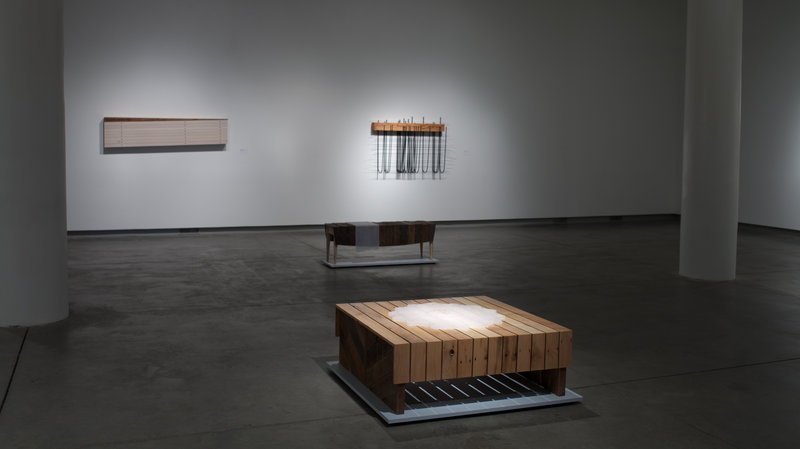Usually, the art we see gathered in galleries and museums is organized by curators and gallerists rather than the artists themselves.
In the 2011 Maine College of Art faculty show, however, each of the three professors selected by juror Patricia Hickson (a curator of contemporary art at the Wadsworth Atheneum Museum of Art in Hartford, Conn.) was able to invite another artist with whom their work would be shown.
The result is an exceptional exhibition.
In years past, the MECA faculty show was often a complete mess. All of the faculty was invited to self-select, so the result was, as often as not, chaotic and visually incoherent. Of course, it was a better way for the public to get an idea about the range of talent, interest and production among the MECA faculty, so, if for that reason alone, it was usually a satisfying and interesting showcase.
I can’t imagine it was a popular decision among the faculty to deny the vast majority of them the chance to exhibit in the Institute of Contemporary Art’s handsome space. However that decision came about, it’s an impressive sign that MECA and the ICA once again have chosen to move in the direction of excellence.
While “A Perceptual Present” is sharply divided into three distinct pairings, there are several conceptual kernels that connect them, including, most notably, the viral logic of cultural destruction made possible by technological progress.
Judith Allen-Efstathiou selected her daughter, Eirene Efstathiou. Together, their installation of drawings and “archives” coalesces seamlessly around the sad truth about how Greece, seeking to give Athens a fresh tropical look for the 2004 Olympics, tore out many old trees only to replace them with imported palms infested with a deadly parasite. Rather than a fresh facelift, the result was a bunch of dead trees that came crashing down now and again amongst the international visitors.
Matt Hutton selected his old friend, Cory Robinson. Their sculptures are made of wood repurposed from old Indiana barns. The story behind their project is similarly sad: When owners of aging barns in Indiana got wind of a market for the wood from old barns, many tore down the structures to sell the wood and put up in their place prefabricated and catalog-designed buildings of plastic, metal and cheap materials. Alas, by flooding this largely-imagined market, the folks seeking to sell the wood quickly ran out of buyers.
The most brilliant and exciting combination is MECA’s Philip Brou and Brussels/New York artist Johan Grimonprez.
Brou’s work eerily and obsessively documents Room 233 of the Comfort Inn in South Portland, where Mohammad Atta and Abdulaziz Alomari stayed the night before they hijacked an airliner and flew it into the World Trade Center on 9/11.
Grimonprez’s film “Dial H-I-S-T-O-R-Y,” which was featured at Documenta X (Kassel) and won Best Director awards at the San Francisco Film Festival and Toronto’s Images Festival, is a historically comprehensive and artfully quirky consideration of hijacking as a cultural and political tool.
Grimonprez’s hour-long film is extraordinary. It’s fascinating, informative and provocative. The artist uses the low-quality video of newsreels and other found footage to stitch together a campy and yet terrifyingly compelling wake-up call that terrorism is not just a rarified political weapon of extremists but part of our cultural reality.
One of the most poignant moments of the film occurs when a 14-year old boy is interviewed after surviving a hijacking. He describes the terrorists as “nice” and reports that the experience was “fun.” That boy is us — the audience — and it’s insidiously easy to understand his excitement while watching Grimonprez’s entertaining film.
While Brou’s paintings and architectural drawings of Room 233 seem to blend a stalker’s obsessiveness with Andy Warhol’s darkest pop sensibilities, his “Black Box” diorama (purchased by the Portland Museum of Art) implicates the viewer much as Grimonprez’s film does.
While referring overtly to a plane’s “black box,” Brou’s object looks like a giant movie camera. The viewer peers back through the lens to see a perfect replica of Room 233, but the experience echoes a peephole made to watch the sexual activities of guests at a cheap hotel.
Like Marcel Duchamp’s “tant Donnes” installation at the Philadelphia Museum of Art, there is something dirty and wrong — but powerful — about assuming the voyeuristic viewpoint.
I was also particularly impressed by Robinson’s and Hutton’s sculptures and “furniture.” Between their impeccable (and palpably self-conscious) craftsmanship and handsome use of space, they make for a beautiful and intriguing installation.
Their best quality, however, is their mystery. It’s so savory, you don’t want to parse the objects for specific meanings or storylines. Their delicious silence makes for an almost hallowed sense of place, even if it is shadowed by a liminal wisp of forgotten atrocity.
While part of me misses the raucous circuses of past MECA faculty shows, “A Perceputal Present” is strong enough to make the case that the ICA deserves national attention.
Whatever is going on at the ICA, I hope they keep it up.
Freelance writer Daniel Kany is an art historian who lives in Cumberland. He can be contacted at:
dankany@gmail.com
Send questions/comments to the editors.



Success. Please wait for the page to reload. If the page does not reload within 5 seconds, please refresh the page.
Enter your email and password to access comments.
Hi, to comment on stories you must . This profile is in addition to your subscription and website login.
Already have a commenting profile? .
Invalid username/password.
Please check your email to confirm and complete your registration.
Only subscribers are eligible to post comments. Please subscribe or login first for digital access. Here’s why.
Use the form below to reset your password. When you've submitted your account email, we will send an email with a reset code.